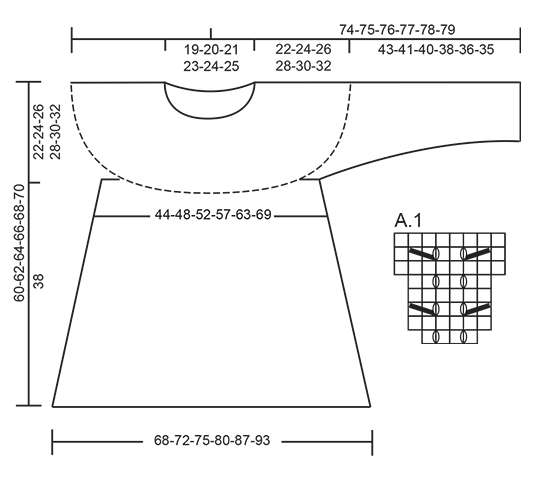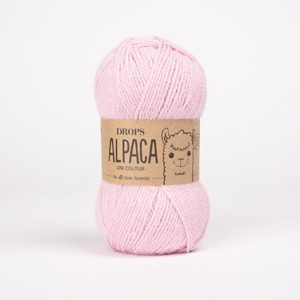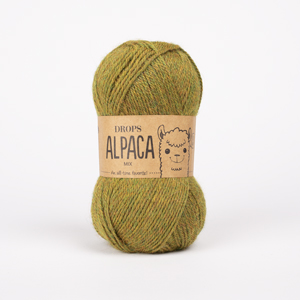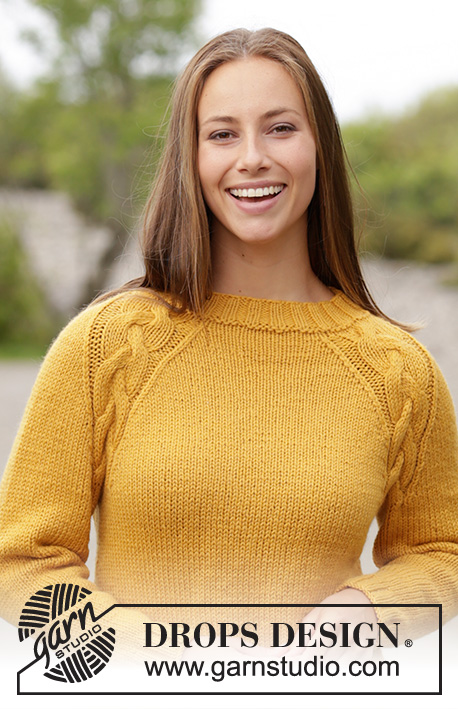Comments / Questions (15)
![]() Luisa wrote:
Luisa wrote:
Liebes DROPS-Team, ich habe folgendes Problem: nachdem ich die Erhöhung gestrickt habe und dann in Runden rechts weiter ergibt sich bei mir rechtsseits der Erhöhung ein Loch, welches aber nicht durch Umschläge entsteht. Wie kann ich das verhindern? Ich vermute, dass ein Versatz zwischen eigentlicher Halsblende und der letzten Reihe der Erhöhung entsteht.
25.06.2024 - 03:42DROPS Design answered:
Liebe Luisa, das kann wegen verkürzten Reihen sein, um dieses Loch zu vermeiden/schliessen können Sie einen Faden zwichen dem Übergang auffassen und verschränkt mit der nächsten Maschen stricken. Viel Spaß beim Stricken!
25.06.2024 - 09:11
![]() Nicole wrote:
Nicole wrote:
Hallo zusammen, ich habe angefangen 7 cm gestrickt. Die 6 Reihen kraus am Kragen legen sich auf die Vorderseite um. Ist das normal, geht das durchs Tragen weg? Bin schon am Überlegen alles nochmal aufzuziehen und gleich als rechts/links-Bündchen zu machen . Herzlichen Dank vorab und viele Grüße, Nicole
09.03.2024 - 09:14DROPS Design answered:
Libe Nicole, ie können den Pullover danach mit Stecknadeln auf einer geeigneten Unterlage spannen, anfeuchten (z.B. mit einer Sprühflasche für Blumen) und trocknen lassen, danach entfernen Sie die Stecknadeln, dann sollte sich der Kragen nicht mehr rollen.
11.03.2024 - 07:49
![]() Desvignes Victoria wrote:
Desvignes Victoria wrote:
J'ai besoin de faire la taille XXXL mais pour l'empiècement je dois augmenter de 176 mailles à intervalles réguliers en partant de 320 mailles pour en obtenir 476. La division ne donne pas un nombre entier: 1.81 . Je fais comment?
15.03.2021 - 17:02DROPS Design answered:
Bonjour Mme Desvignes, cette leçon explique comment répartir des augmentations à intervalles réguliers en fonction du nombre de mailles/de diminutions et du résultat, comment arrondir, etc... Bon tricot!
16.03.2021 - 08:25
![]() Winnie Albrecht wrote:
Winnie Albrecht wrote:
Maschenprobe stimmte, Genau nach Anleitung gestrickt, Leider eine furchtbare Passform, der Pullover sieht nur im Stehen gut aus. Sobald ich sitze oder mich bewege rutscht alles hoch. Schade um die Arbeit
06.01.2020 - 19:38DROPS Design answered:
Liebe Frau Albrecht, Ihr Strickstück Ihrem DROPS Laden bitte zeigen (auch mal im Foto), gerne bekommen Sie dann persönnliche Hilfe. Viel Spaß beim stricken!
07.01.2020 - 09:14
![]() De Lee Gina wrote:
De Lee Gina wrote:
Evergreen by DROPS Design Gebreide trui met ronde pas, Valse patentsteek en A-lijn, van boven naar beneden gebreid. Maten S - XXXL. Het werk wordt gebreid in DROPS Alpaca. Hoe kan ik dit bestellen in maat M met het nodige materiaal ?
30.01.2019 - 10:18DROPS Design answered:
Dag De Lee Gina,
Voor maat M heb je 450 g Alpaca van kleur 7233, geel/groen nodig. Deze kun je bijvoorbeeld bestellen via een van onze verkooppunten
30.01.2019 - 16:12
![]() Nanna Thune Andersen wrote:
Nanna Thune Andersen wrote:
Hejsa Hvordan downloader jeg denne opskrift? Evergreen Mvh Nanna
22.12.2018 - 14:53DROPS Design answered:
Hei Nanna. Vi har dessverre ikke noen downloadfunksjon på vår side, da må du kopiere og så lagre den selv, eventuelt ta en screen shot. Vi har en funksjon for å printe den ut om du ønsker det. God fornøyelse
02.01.2019 - 10:06
![]() Bettina Baudach wrote:
Bettina Baudach wrote:
Hallo liebes Dropsteam, ich finde das Modell ganz toll, bekomme aber nicht einen so großen Ausschnitt wie auf dem Foto. Müssen mehr Maschen aufgenommen werden? Meine Maschenprobe war korrekt.
29.07.2018 - 17:38DROPS Design answered:
Liebe Frau Badach, sollte Ihre Maschenprobe stimmen, dann sollen Sie die genaue Maßen wie in der Maßskizze bekommen. Beachten Sie, daß Sie auch beim stricken immer noch die gleiche Maschenprobe haben. Viel Spaß beim stricken!
31.07.2018 - 09:20
![]() Ingrid Cardinaels wrote:
Ingrid Cardinaels wrote:
Dit is mijn eerste trui breien van boven naar beneden. Is er een filmpje over het breien met een half achterpand. Ik vind wel filmpjes over raglan mouwen, maar niet dit soort mouw. Ik zit nu vast in de pas bij de laatste meerdering.
27.03.2018 - 13:38DROPS Design answered:
Hallo Ingrid, Bedoel je de meerderingen die je maakt voordat de steken verdeeld worden voor mouwen en lijf? Je kunt dan zien bij 'Tip voor meerderen'. De meerderingen maak je door een omslag te maken.
02.04.2018 - 14:37
![]() Nicole wrote:
Nicole wrote:
Hallo liebes Drops-Team Ich habe im PAtent einen Fehler entdeckt und nun die beiden betreffenden Maschen „fallenlassen“. Aber ich kann sie jetzt doch nicht mehr richtig hochholen. Habt ihr dafür auch ein Video? Lieben Dank
08.01.2018 - 21:40DROPS Design answered:
Liebe Nicole, vielleicht kann Ihnen dieses Video helfen. Viel Spaß beim stricken!
09.01.2018 - 09:37
![]() Christine Roderick wrote:
Christine Roderick wrote:
Love this and your 2 beautiful models. Ordering my yarn today
18.12.2017 - 14:53
Evergreen#evergreensweater |
|||||||||||||
 |
 |
||||||||||||
Knitted jumper with round yoke, English rib and A-shape, worked top down. Sizes S - XXXL. The piece is worked in DROPS Alpaca.
DROPS 180-11 |
|||||||||||||
|
INFORMATION FOR THE PATTERN: RIDGE/GARTER STITCH (worked in the round): 1 ridge = 2 rounds. Knit 1 round and purl 1 round. INCREASE TIP: To work out how to increase evenly, count the total number of stitches on the needle (e.g. 140 stitches) and divide by the number of increases to be made (e.g. 20) = 7. In this example, increase after every 7th stitch by making 1 yarn over. On the next round knit the yarn overs twisted to prevent holes. ELEVATION: Insert 1 marker at the beginning of the round = mid back. Start from the right side and knit 8-8-9-9-10-11 stitches past the marker, turn, tighten the strand and purl 16-16-18-18-20-22 stitches. Turn, tighten the strand and knit 24-24-27-27-30-33 stitches, turn, tighten the strand and purl 32-32-36-36-40-44 stitches. Continue back and forth in this way by working 8-8-9-9-10-11 stitches more each time you turn (remember to tighten the strand each time you turn) until you have worked back and forth over a total of 64-64-72-72-80-88 stitches and the last row is worked from the wrong side. Turn, tighten the strand and knit to mid back. ENGLISH RIB: ROUND 1: * make 1 yarn over, slip 1 stitch as if to purl (insert the right needle into the stitch on the left needle, from right to left), knit 1 *, repeat from *-* to end of round. ROUND 2: * Purl the yarn over and slipped stitch together, make 1 yarn over, slip 1 stitch as if to purl *, repeat from *-* to end of round. ROUND 3: * Make 1 yarn over, slip 1 stitch as if to purl, knit the yarn over and the slipped stitch together *, repeat from *-* to end of round. Repeat round 2 and 3. DECREASE TIP (for mid under the sleeve): Start 3 stitches before the marker thread, knit 2 together, knit 2 (the marker thread sits between these 2 stitches), slip 1 stitch as if to knit, knit 1, pass the slipped stitch over the knitted stitch (= 2 stitches decreased). ---------------------------------------------------------- JUMPER: The piece is worked in the round with circular needle, top down. The sleeves are worked in the round with short circular needle, top down. Change to double pointed needles when necessary. NECKLINE: Cast on 108-116-122-128-134-140 stitches with circular needle size 2.5 mm and Alpaca. Work 3 RIDGES – see description above. Then knit 1 round where you increase 2-4-8-12-16-20 stitches evenly on round – read INCREASE TIP = 110-120-130-140-150-160 stitches. Continue the yoke as described below. YOKE: Keep the stitches on circular needle size 2.5 mm. For a better fit, you can now work an ELEVATION in the back of the neck – see description above. When the elevation has been completed, work stocking stitch in the round. When the piece measures 2 cm from the cast-on edge mid front, increase 110-120-130-140-150-160 stitches evenly on round by making 1 yarn over after every stitch on the needle = 220-240-260-280-300-320 stitches. Continue working stocking stitch, but on the first round, knit the yarn overs twisted to prevent holes. REMEMBER THE KNITTING TENSION! When the piece measures 3 cm from the cast-on edge mid front, work the next round as follows: * purl 1, knit 1 *, repeat from *-* to end of round. When you have worked 4-4-4-6-6-6 rounds of rib, continue with ENGLISH RIB – see description above. When the piece measures 6-6-6-7-7-7 cm from the cast-on edge mid front, change to circular needle size 3 mm. Continue with English rib. When the piece measures 21-23-25-27-29-31 cm from the cast-on edge mid front (adjust so that last round is 2nd round of English rib) and work the next round as follows: * Purl the yarn over and slipped stitch together, knit 1 *, repeat from *-* to end of round. Then knit 1 round where you increase 112-132-140-152-168-176 stitches evenly on round – remember INCREASE TIP = 332-372-400-432-468-496 stitches. The next round is worked as follows: Knit 49-54-57-63-70-76 stitches (= ½ back piece), place the next 68-78-86-90-94-96 stitches on a thread for sleeve, cast on 8-8-10-10-12-14 new stitches on the needle (= in the side under the sleeve), knit 98-108-114-126-140-152 stitches (= front piece), place the next 68-78-86-90-94-96 stitches on a thread for sleeve, cast on 8-8-10-10-12-14 stitches on the needle (= in the side under the sleeve) and knit the remaining 49-54-57-63-70-76 stitches (= ½ back piece). Cut the strand. Body and sleeves are now finished separately. THE PIECE IS NOW MEASURED FROM HERE! BODY: = 212-232-248-272-304-332 stitches. Insert 1 marker thread in the middle of the 8-8-10-10-12-14 stitches which were cast on under the sleeve in each side and allow the marker threads to follow your work upwards. Start the round by one of the marker threads and work stocking stitch in the round. When the piece measures 2 cm from the separation, work A.1 over the middle 4 stitches in each side, i.e. start 2 stitches before the marker thread at the beginning of the round, work A.1, work stocking stitch until there are 2 stitches left before the marker thread in the other side, work A.1 and work stocking stitch to end of round = 4 stitches increased. Continue in this way with stocking stitch and A.1 in each side, i.e. you will get a row of holes in each side of the body and increase 2 stitches in each side every 4th round. When the piece measures 37 cm from the separation there are approx. 324-344-360-384-416-444 stitches on the needle (if the knitting tension is right, this will be the equivalent of 28 increase-rounds in each side). Work 3 ridges in the round. Then cast off with knit, but to avoid the cast-off edge being tight, make 1 yarn over after approx. every 8th stitch at the same time as you cast off (the yarn overs are cast off as normal stitches). The jumper measures approx. 60-62-64-66-68-70 cm from the shoulder down. SLEEVES: Place the 68-78-86-90-94-96 stitches from the thread in the one side of the piece on short circular needle size 3 mm, in addition knit up 1 stitch in each of the 8-8-10-10-12-14 stitches which were cast on under the sleeve = 76-86-96-100-106-110 stitches. Insert 1 marker thread in the middle of the 8-8-10-10-12-14 stitches. Start the round by the marker thread and work stocking stitch in the round. When the piece measures 2-2-3-3-4-4 cm from the separation, decrease 2 stitches mid under the sleeve – read DECREASE TIP. Decrease in this way every 3-2-1½-1½-1-1 cm a total of 13-17-20-21-22-22 times = 50-52-56-58-62-66 stitches. Continue working until the sleeve measures 42-40-39-37-35-34 cm from the separation (shorter measurements in larger sizes because of longer yoke). Change to double pointed needles size 2.5 mm and work 3 ridges in the round. Then cast off with knit, but to avoid the cast-off edge being tight, make 1 yarn over after every 8th stitch at the same time as you cast off. The sleeve measures approx. 43-41-40-38-36-35 cm from the separation. Work the other sleeve in the same way. SHAPING: To get an even texture to the English rib, dampen the whole garment. Gently press out the extra water (without twisting the garment). Then lay the jumper flat, in shape and according to measurements until it is dry. |
|||||||||||||
Diagram explanations |
|||||||||||||
|
|||||||||||||

|
|||||||||||||
Have you finished this pattern?Tag your pictures with #dropspattern #evergreensweater or submit them to the #dropsfan gallery. Do you need help with this pattern?You'll find 29 tutorial videos, a Comments/Questions area and more by visiting the pattern on garnstudio.com. © 1982-2025 DROPS Design A/S. We reserve all rights. This document, including all its sub-sections, has copyrights. Read more about what you can do with our patterns at the bottom of each pattern on our site. |
|||||||||||||










































































Post a comment to pattern DROPS 180-11
We would love to hear what you have to say about this pattern!
If you want to leave a question, please make sure you select the correct category in the form below, to speed up the answering process. Required fields are marked *.